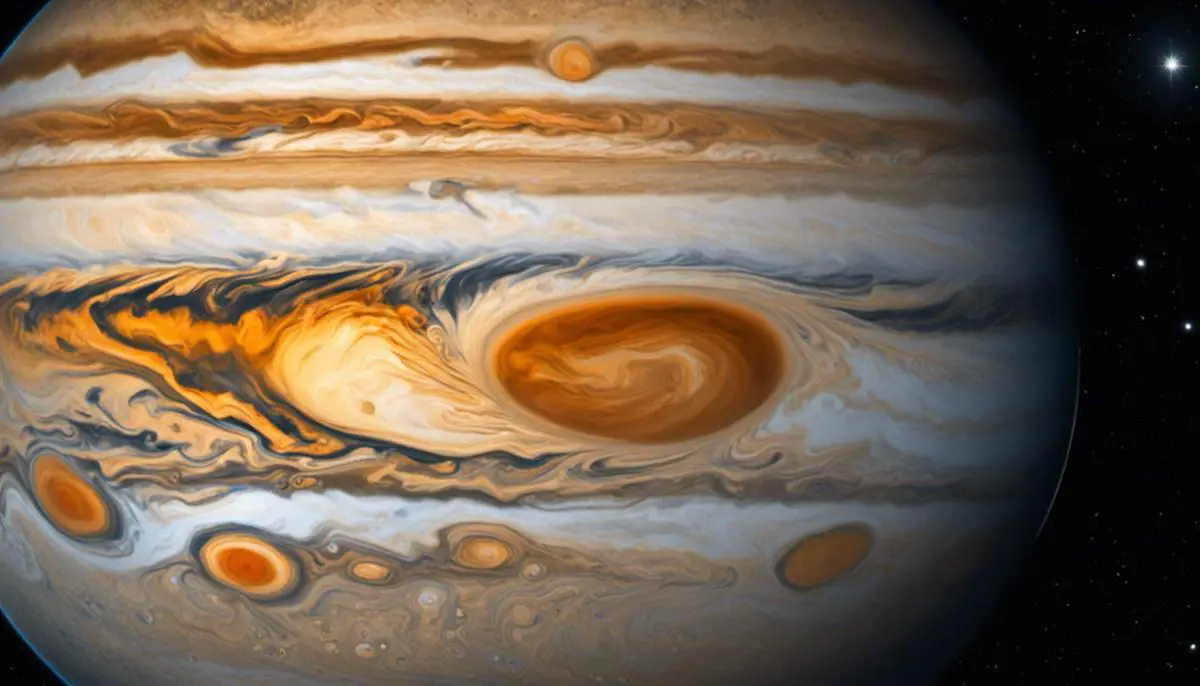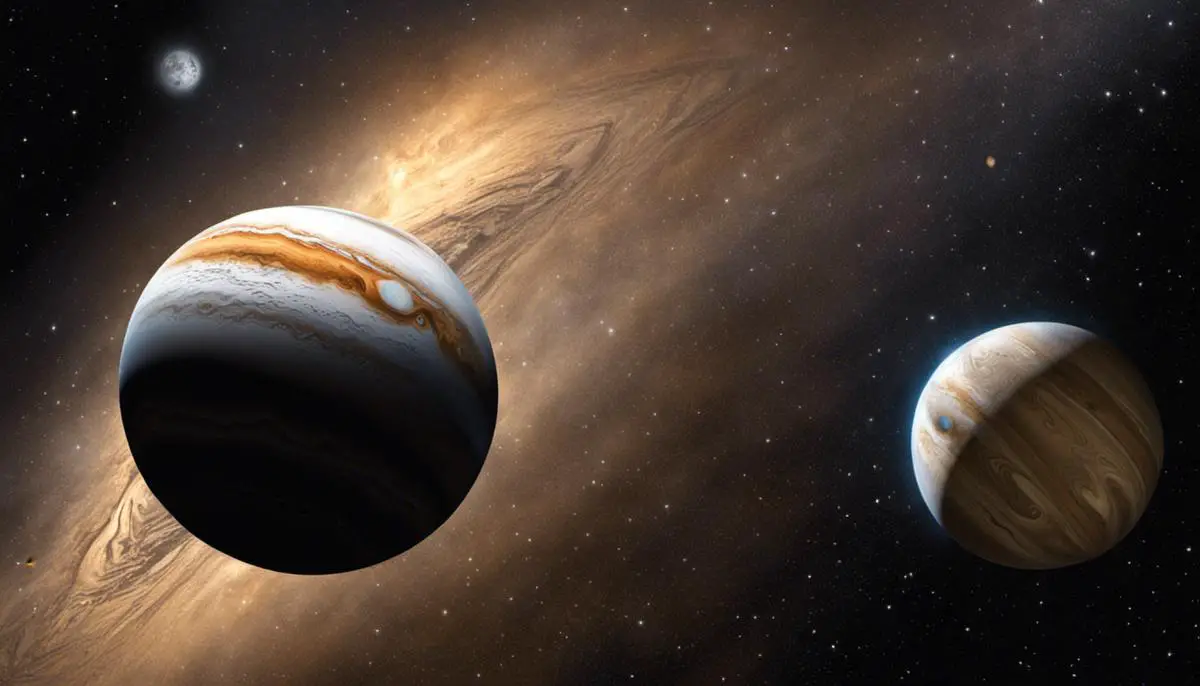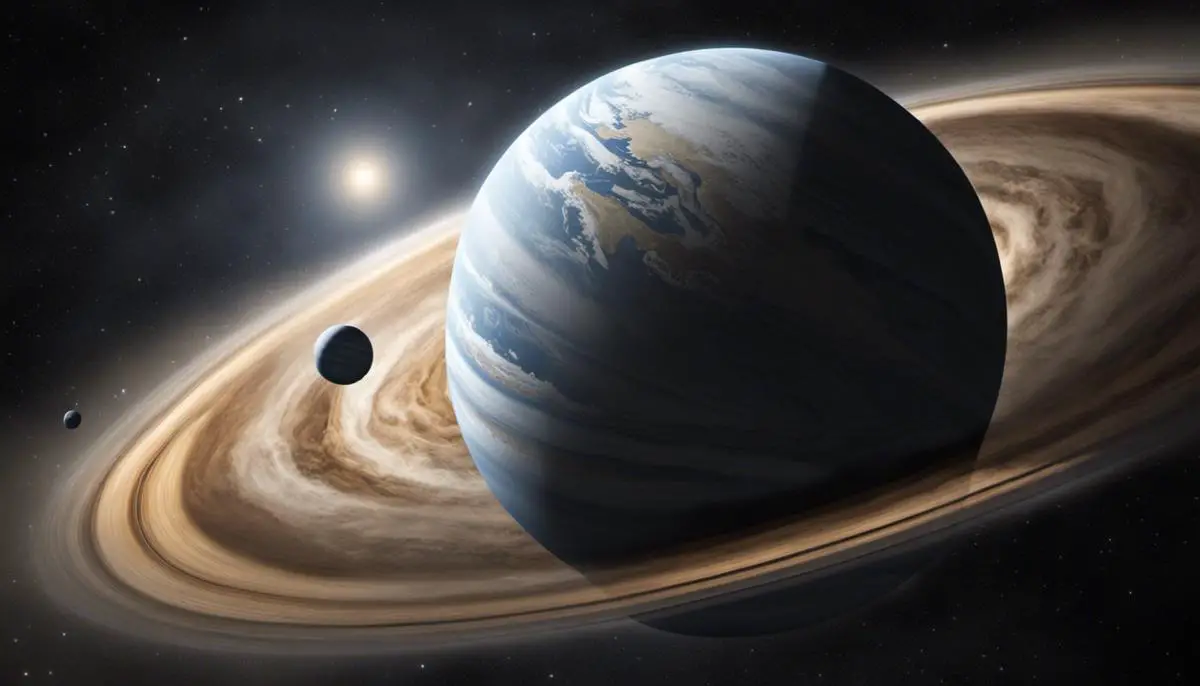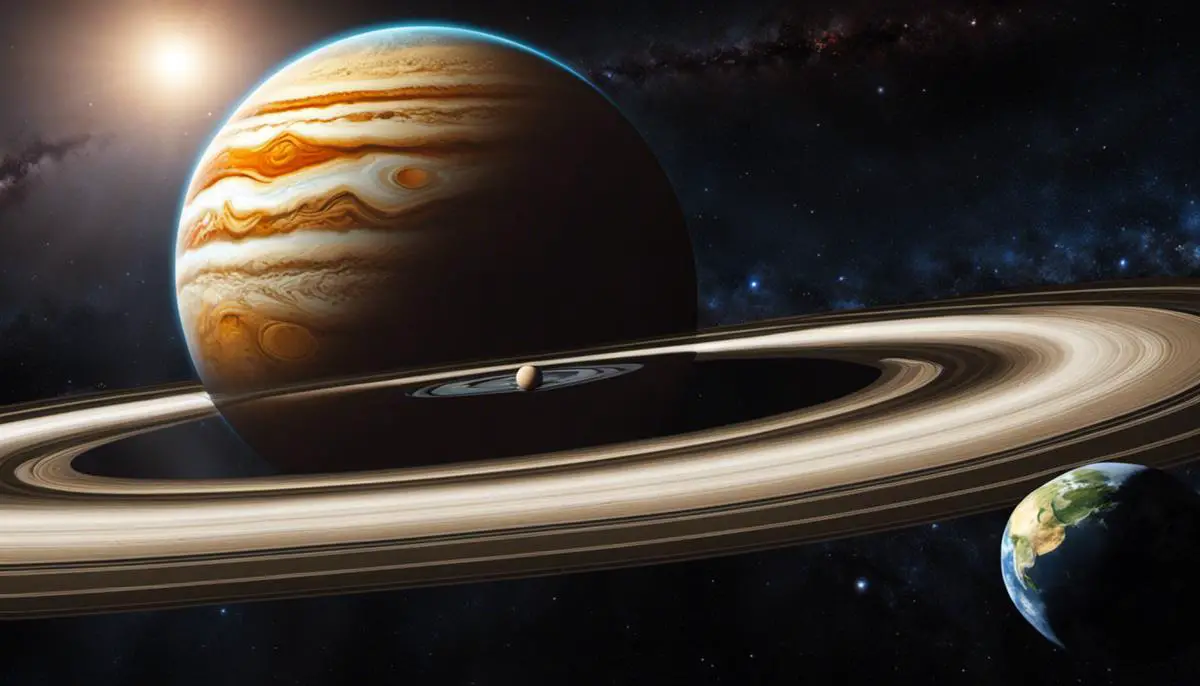In our expansive and complex solar system, each celestial body plays a pivotal role and has a significant impact on others. Among these, Jupiter, the largest planet in our solar system, holds an intriguing position due to its enormous size and strong gravitational pull. Its enormous distance from the sun and Earth, along with its physical characteristics and orbit, contribute significantly to its interaction with other celestial bodies and its potential effects on Earth. This article will uncover the mysteries of this giant gas planet, focusing primarily on its gravitational pull, the influence it has on asteroids, and its effects on Earth’s climate.
Jupiter’s position in the solar system
Jupiter’s Position and Physical Description
Jupiter is the fifth planet from the Sun and the biggest planet in our solar system. It is located about 5.2 astronomical units (AU) from the Sun, which equates to approximately 484 million miles. In comparison, Earth is roughly one AU, or 93 million miles, from the Sun. This means the average distance between Earth and Jupiter varies from about 380 to 590 million miles, depending on their positions in their respective orbits.
Jupiter is a gas giant made primarily of hydrogen and helium, nearly four times the size of Earth. It has a powerful magnetic field, dozens of moons, and a massive system of rings. It is perhaps most known for its Great Red Spot, a storm that has been raging on the planet for hundreds of years.
Jupiter’s Orbit and Interactions with Other Celestial Bodies
The planet Jupiter takes about 11.86 Earth years to complete one orbit around the Sun, while its day – the time it takes to rotate on its axis – is a swift 9.92 Earth hours, the shortest of all the planets. This rapid rotation contributes to its flattened shape, with its equatorial diameter more than 7% larger than the pole-to-pole diameter.
From Earth, Jupiter is one of the five planets visible to the naked eye. Jupiter is responsible for affecting several asteroid groups: the Trojans, Greeks, and Hildas. Its massive gravity tugs on these asteroids, forcing them into specific orbits.
Effects of Jupiter’s Distance on Earth
A major way Jupiter affects Earth is by influencing the latter’s long-term climate cycles. Scientists believe that Jupiter (together with Saturn) has a significant effect on Earth’s Milankovitch cycles, which drive alternating periods of glaciations and warmer interglacials. These include changes in Earth’s eccentricity (the shape of its orbit around the Sun) and obliquity (the tilt of Earth’s axis).
More significantly, some scientists argue that Jupiter, being the largest planet in our solar system, plays a crucial role in shielding Earth from many comets and asteroids. Its strong gravitational pull acts as a “cosmic vacuum cleaner” by attracting these space objects that may otherwise hit our planet.
Conversely, Jupiter’s gravitational force can occasionally deflect objects inwards, as it did with the comet Shoemaker-Levy 9 in 1994. This showcases the dual role that Jupiter serves: as a shield from and catalyst for potential impacts on Earth.
Furthermore, Jupiter’s distance from the Earth affects our ability to study it. The greater distance makes it more challenging to send spacecrafts, due to longer travel times and the need for more energy and resources.
Despite being a considerable distance away, Jupiter’s expansive size, potent gravitational field, and strategic placement in our solar system significantly impact everything from the solar system’s overall structure to specific conditions on Earth.

Gravitational pull and Asteroids
How Jupiter’s Gravity Impacts Asteroids
As the largest planet in our solar system, Jupiter has the power to maneuver asteroids and other celestial bodies, thus keeping Earth safe. This is all thanks to its incredible gravitational pull, which can alter the course of passing asteroids, often diverting them into orbits that do not intersect with Earth.
Tug-of-War in Space: Jupiter’s Gravity and Asteroid Trajectories
Jupiter’s powerful gravitational force acts similar to a cosmic shield, protecting the inner solar system, including Earth, from potential asteroid impacts. Specifically, it changes asteroids’ trajectories by creating a “gravitational keyhole.” This is a region in space where an asteroid’s path can be altered due to a planet’s gravity, in this case, Jupiter’s. When asteroids pass near to Jupiter, they are either pulled into the planet or their trajectory is altered, preventing them from colliding with Earth.
Jupiter and the Asteroid Belt: A Barrier against Impacts
One of the main asteroid sources in the solar system is the asteroid belt, located between the orbits of Mars and Jupiter. The presence of Jupiter actually prevents these asteroids from being flung into the inner solar system. Essentially, Jupiter’s significant gravitational act dissuades these celestial bodies from straying and possibly colliding with Earth.
Historical Examples and Simulations Studies: Jupiter’s Protective Influence
Historical data and simulation studies have long observed Jupiter’s protective effect against asteroids. For instance, the comet Shoemaker-Levy 9 was drawn into Jupiter’s gravity and broke apart before it collided with the planet in 1994, creating multiple impact marks visible even from Earth.
Moreover, a study published in the “Astronomy and Astrophysics” journal in 2012 used simulations to understand Jupiter’s effect on asteroids. The researchers concluded that Jupiter’s gravitational influence does indeed divert potential Earth-impacting asteroids, providing a type of cosmic shield for our planet.
Jupiter’s Role in Asteroid Defense: A Matter of Perfect Distance
Jupiter’s responsibility in safeguarding the Earth from asteroid impacts is pivotal, but it’s the distance from Earth that plays an essential role in this arrangement. If Jupiter were too close to Earth, its powerful gravitational pull could attract asteroids in our direction, increasing the potential for catastrophic asteroid impacts. Positioned at an average distance of around 484 million miles from Earth, Jupiter’s gravitational reach strikes a balance, enabling it to ward off harmful asteroids without pulling them toward our planet.

Jupiter’s influence on Earth’s climate
The Protective Blanket of Jupiter’s Gravity
Jupiter’s large size combined with its considerable distance from Earth results in a significant gravitational influence on our planet. Despite being an average of 484 million miles away, Jupiter, the largest planet in our solar system, still exerts a gravitational pull on Earth that helps maintain our planet’s stability.
Scientists in the field of planetary study assert that Jupiter’s considerable gravitational force contributes to the stability of Earth’s orbit around the Sun. This reliable and predictable orbit allows for more stable climate conditions on Earth—a prerequisite for fostering and preserving life.
The Jupiter Shield Theory
A popular theory known as the “Jupiter Shield” theory posits that Jupiter’s enormous gravitational pull also protects Earth from space debris, including comets and asteroids. This theory suggests that Jupiter, due to its strong gravitational force, deflects or captures many of these celestial bodies that might otherwise strike Earth, thus substantially reducing the chances of catastrophic events.
However, the Jupiter Shield theory is not universally accepted. Some suggest it’s as likely that Jupiter’s gravitational pull could slingshot incoming objects into the inner solar system and towards Earth. A large asteroid or comet impact could potentially cause a mass extinction event, similar to what is theorized to have happened to the dinosaurs.
The Influence on Earth’s Long-Term Climate
Jupiter may also have a long-term effect on Earth’s climate due to the gravitational interactions and resonances between the two planets. Resonances occur when two bodies exert a regular, periodic gravitational influence on each other. For Earth and Jupiter, this happens approximately every 179 years, and may cause small perturbations in Earth’s orbit and climate.
A 2016 scientific study published by the Proceedings of the National Academy of Sciences linked the Earth’s ice ages to astronomical cycles, and specifically to Jupiter’s and Venus’s gravitational pull on Earth. The study suggested that every 405,000 years, due to gravitational resonances with Jupiter and Venus, the Earth’s orbit slightly elongates. This reportedly leads to climatic variations on Earth over time scales of hundreds of thousands to millions of years.
Conclusion: A Delicate Balance in The Solar System
In summary, Jupiter’s distance and massive gravitational force can have a variety of significant effects on Earth, from maintaining the relative stability of Earth’s orbit to possibly influencing long-term climate patterns. These effects highlight the delicate balance of gravitational forces in our solar system and reinforce the interconnectivity of celestial bodies, even across vast distances.

After examining the various aspects of Jupiter’s influence on the Earth, it becomes clear that the largest planet in our solar system plays a more significant role in our everyday lives than we might have thought. From deflecting asteroids that could pose a threat to our planet, to potentially stabilising Earth’s climate and orbital patterns, Jupiter’s gravitational effect and strategic distance from Earth are indeed fascinating. While researchers may continue to debate some aspects, the consensus remains that Jupiter’s presence certainly adds an essential layer to our understanding of the extraordinary system we inhabit. The exploration and study of Jupiter will undoubtedly continue to yield incredible insights, emphasizing the interconnectedness of the cosmos.
FAQ
How long will it take to get to Jupiter from Earth?
The spacecraft’s speed, trajectory, and the relative positions of the two planets in their orbits all affect how long it takes to get from Earth to Jupiter. A spacecraft moving at the usual speed for deep space missions, like the New Horizons or Juno probes, may take roughly 13 to 15 months to reach Jupiter under ideal circumstances, when Earth and Jupiter are aligned favorably. The Hohmann transfer orbit, a fuel-efficient path that takes advantage of the planets’ gravitational pull on one another, is assumed in this estimate. However, depending on the details of the mission, the propulsion system, and the launch window, the journey time may change. Faster spacecraft with more sophisticated propulsion systems might shorten the trip, but less effective paths or unfavorable planetary alignments might make the trip take longer.
How close can a human get to Jupiter?
Unlike Earth, Jupiter is a gas giant with no solid surface that is primarily made of hydrogen and helium. As such, there’s no discernible “surface” to land on, and any attempt to approach Jupiter would require negotiating its tumultuous outer atmosphere. Thick layers of gas, along by strong radiation and violent storm bands, make up Jupiter’s atmosphere. Because of these harsh circumstances and the absence of a stable landing site, it is not possible for humans to approach Jupiter in a fashion that allows spacecraft to flyby or penetrate its atmosphere for scientific research. Sending robotic probes to investigate this massive gas giant instead of undertaking manned trips is the principal strategy for future human exploration of Jupiter.
How far is Jupiter from Earth in light minutes?
Because of their elliptical orbits around the Sun, Jupiter and Earth have different distances from one another. Jupiter is roughly 35.8 light-minutes distant from Earth on average. This indicates that it takes light 35.8 minutes to travel from Jupiter to Earth, or vice versa, at a speed of roughly 186,282 miles per second (299,792 kilometers per second). This amount, however, might vary from roughly 32 to 52 light-minutes, depending on the positions of the two planets in their respective orbits, as they are both in perpetual motion. The vastness of our solar system and the time it takes for light signals to travel across enormous cosmic distances are better understood by using the concept of measuring astronomical distances in light-minutes.
How long is 1 Jupiter day?
Jupiter is a gas giant that lacks a solid surface. Additionally, the planet’s rotation is uneven, causing various regions to rotate at varying speeds. The equator of the earth rotates more quickly than the polar areas. This makes it difficult to assign a single “day” to Jupiter. Astronomers, however, frequently employ Jupiter’s equatorial rotation mechanism, which takes the planet nine hours and fifty-five minutes to complete one round. The polar regions, on the other hand, rotate every 9 hours and 56 minutes. Therefore, one Jupiter day can vary from roughly nine hours and fifty-five minutes to nine hours and sixty-six minutes, depending on the location of reference, due to the uneven rotation throughout its enormous atmosphere.
Can we visit Jupiter?
Currently available space exploration technology are not yet capable of carrying out crewed mission visits to Jupiter. As a gas giant, Jupiter lacks a flat surface on which spacecraft may land. The tumultuous atmosphere, powerful radiation bands, and strong gravitational pull provide formidable obstacles to human exploration. Though many spacecraft have made flybys or orbited Jupiter to study it remotely, including Pioneer, Voyager, Galileo, and Juno, putting humans on Jupiter is a very difficult and resource-intensive project. Plans for crewed missions to Jupiter are frequently centered on the interesting moon Europa, which is thought to harbor the potential for life and a subterranean ocean. However, a human expedition to Jupiter or any of its moons would be a far-off dream for the future of human space exploration, requiring significant preparation, long-duration space travel skills, and technological breakthroughs.
![]()
